Vascular Access Service
What is the Vascular Access Service?
The Vascular Access Service team works with children and teens who need medicine put directly into their vein. Our goal is to minimize discomfort while making sure you and your child feel empowered and knowledgeable about intravenous (IV) therapy during your child’s hospital stay or at home.
Vascular Access Service helps put medicine and fluids into your child’s IV and draws blood samples from your child’s IV, including PICC (peripherally inserted central catheter) line and central lines. We can also help if the line needs to be fixed.
If your child needs to go home with a central line, we will teach you how to take of care of it in partnership with your home care company.
Why does my child need an IV, central line or access port?
- Some medicines can’t be taken by mouth or by injection and need to be put directly into the vein
- Your child may not be able to take the medicine by mouth or injection
- To draw blood
Who does the Vascular Access Service treat?
Some of the clinics the Vascular Access Service team commonly partners with are:
- Cancer and Blood Disorders Center
- Dialysis
- Gastroenterology and Hepatology (liver and intestinal failure)
- General Surgery
- Heart Center
- Infectious Diseases and Virology
- Neonatology
What services do we offer?
Peripheral intravenous (PIV)
A PIV is placed at the bedside by a nurse. The nurse can use numbing cream or other strategies to reduce the pain of the needle poke for your child.
This type of IV is usually put on either a hand or arm, and it can also be put on a foot or leg if your child doesn’t walk. After the IV is placed in the vein, a small flexible tube (like spaghetti) stays in the vein. This should not be painful for the child.
This type of IV usually stays in for a couple days. These are used when your child is in the hospital, but occasionally can be used at home (PDF).
Central lines
A central line is a small tube that delivers medicine and fluids to your child into a large vein near their heart. Your child will usually go to the operating room or to interventional radiology where a trained provider will put in the line. It can sometimes be placed at the bedside. For details on the steps that happen when your child needs a central line, see the Central Line Road Map (PDF).
Keeping the line clean and cared for is very important to prevent infection. Your care team ensures this line doesn’t get infected. If your child leaves the hospital with a central line, we will teach you how to take care of it before your child goes home.
-
Broviac single lumen central line catheter
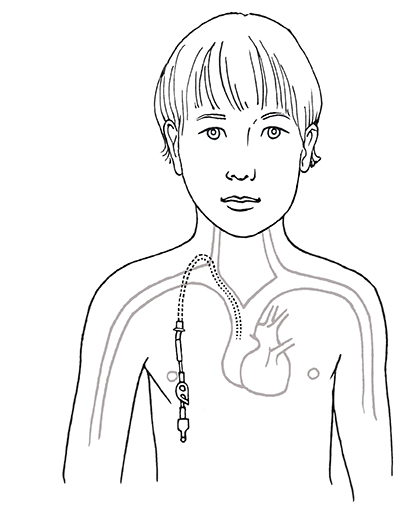 A single lumen tunneled central venous catheter (Broviac central line) is a type of central line.
A single lumen tunneled central venous catheter (Broviac central line) is a type of central line.Broviac Single Lumen Central Line Catheter (PDF) (Dari) (Spanish) (Somali) (Simplified Chinese) (Vietnamese)
-
Hickman double lumen central venous catheter
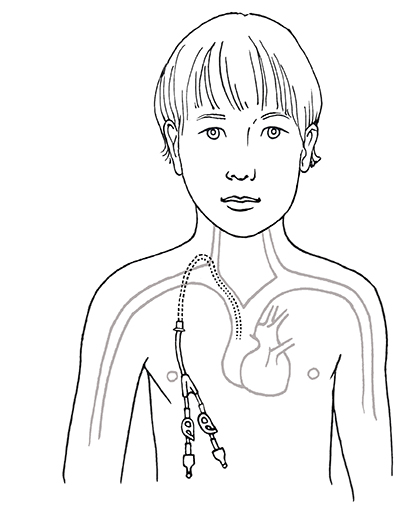 A double lumen tunneled central venous catheter (Hickman central line) is a type of central line.
A double lumen tunneled central venous catheter (Hickman central line) is a type of central line.Double Lumen Central Venous Catheter (PDF) (Marshallese) (Spanish) (Portuguese) (Somali) (Simplified Chinese) (Vietnamese)
-
Implanted port (port-a-cath)
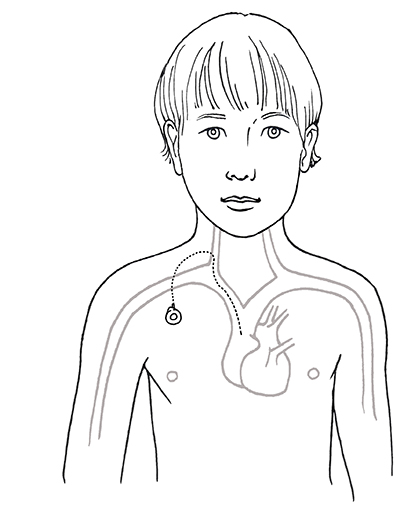 An implanted port is put under your child’s skin and is attached to the catheter that goes to the big vessel near their heart. To access the implanted port, a nurse will poke a needle through the skin and into the implanted port. It is then ready to use for IV medicines or blood draws.
An implanted port is put under your child’s skin and is attached to the catheter that goes to the big vessel near their heart. To access the implanted port, a nurse will poke a needle through the skin and into the implanted port. It is then ready to use for IV medicines or blood draws.If your child will have time between treatments, they may not need to have their port accessed. When the clear dressing and needle are removed, the port is fully under the skin. This helps reduce the chance of infection and allows your child to do activities like showering or bathing without extra steps to care for the line.
Implanted Port (Port-a-Cath) (PDF) (Spanish) (Simplified Chinese) (Somali) (Vietnamese)
-
Peripherally inserted central catheter (PICC)
A peripherally inserted central catheter (PICC) is a type of central line. The catheter usually exits the body at the upper arm. In young children, the catheter will sometimes exit the body at the leg, near the diaper area (groin) or on top of the head (scalp).
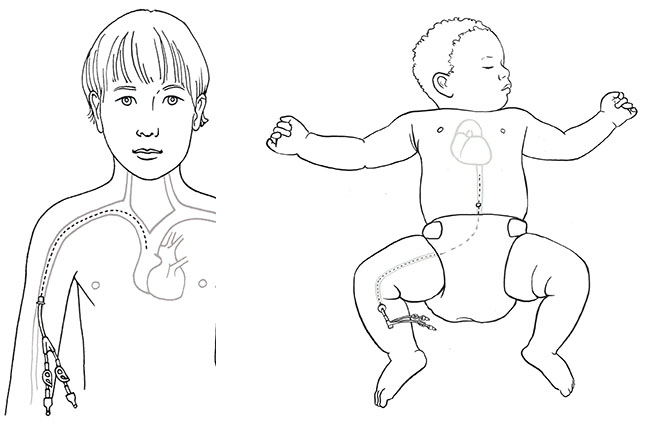
Peripherally Inserted Central Catheter (PICC) (PDF) (Amharic) (Spanish) (Somali) (Simplified Chinese) (Vietnamese)
-
Tunneled central venous catheter used for apheresis
 A central venous catheter is a special type of double central line.
A central venous catheter is a special type of double central line.The tubes usually exit the body at the upper chest. Apheresis means taking your child’s blood out from one of the lumens of the catheter and then passing it through a machine that separates part of the blood and returns it back through the other lumen of the catheter.
Tunneled Central Venous Catheter Used for Apheresis (Apheresis Line) (PDF) (Spanish) (Somali) (Simplified Chinese) (Vietnamese)
-
Temporary central venous catheter (central line)
A temporary central venous catheter is a type of central line. The tube usually exits the body on the side of the neck, the abdomen or the groin.
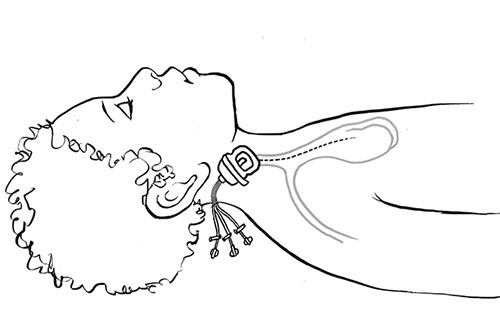
Temporary Central Venous Catheter (PDF) (Spanish) (Somali) (Simplified Chinese) (Vietnamese)
Caring for your child’s central line
Most children who have a central line leave the hospital with it at some point during their treatment. While caring for their central line may seem intimidating at first, we have confidence that practice with your child’s care team and use of the resources below will help you feel ready to do this with your child.
Changing the cap
How to Change the Cap on a Central Line (PDF)
How to flush the line
How to Flush a Central Line (PDF)
Changing the dressing
How to Change a Central Line Dressing With Chlorhexidine (CHG) (PDF)
How to Change a Central Line Dressing – Alternative Dressing Change (PDF)
How to Put on Sterile Gloves (PDF) (Spanish) (Vietnamese)
Treat infiltration or extravasation
An infiltration or extravasation happens if medicines given through PIV leak into the surrounding tissues and cause an injury.
To treat this, a nurse will need to look at it soon. If needed, we will inject medicine around the area to help it heal and watch it over time. Often a warm compress and elevation above the heart level are all that are needed to heal the area. Infiltrations or extravasations usually get better within a couple of days.
Learn more about infiltration or extravasation (PDF) (Spanish).
Central line removal
When your child no longer needs IV medicines or blood draws, we can take the PICC and temporary line out at the bedside. Removing the line doesn’t hurt.
If your child has another type of line, like an implanted port or central line, we will remove it in the operating room or interventional radiology when it is no longer needed. Learn more about Care After PICC Line Removal (PDF) (Spanish).
Treating problems with IV lines
If something happens to your child’s line, whether it’s not working properly, gets clogged, breaks or there’s another issue, the Vascular Access Service team will help. If there is a problem with your child’s line, please call your home care company and let your care team know.
Leadership
-
Division Chief of Interventional Radiology
-
Stephanie Easley, BSN, RN
-
Julia Martinez, BSN, RN, CCRN-K
-

Megan Stimpson, DNP, ARNP-CS, PCNS-BC, VA-BC
Resources for Patients and Families
- IV Care at Home – Information About Your Child's Peripheral IV (PIV) (PDF)
- Infiltration and Extravasation (PDF) (Spanish)
- Your Child’s Intravenous (IV) Antibiotic Treatment Plan at Home (PDF) (Spanish)
- Care After PICC Line Removal (PDF) (Spanish)
Central lines
Types of central lines
- Broviac Single Lumen Central Line Catheter (PDF) (Dari) (Spanish) (Somali) (Simplified Chinese) (Vietnamese)
- Double Lumen Central Venous Catheter (PDF) (Marshallese) (Spanish) (Portuguese) (Somali) (Simplified Chinese) (Vietnamese)
- Implanted Port (Port-a-Cath) (PDF) (Spanish) (Simplified Chinese) (Somali) (Vietnamese)
- Peripherally Inserted Central Catheter (PICC) (PDF) (Amharic) (Spanish) (Somali) (Simplified Chinese) (Vietnamese)
- Temporary Central Venous Catheter (PDF) (Spanish) (Somali) (Simplified Chinese) (Vietnamese)
- Tunneled Central Venous Catheter Used for Apheresis (Apheresis Line) (PDF) (Spanish) (Somali) (Simplified Chinese) (Vietnamese)
Central line care
- How to Change the Cap on a Central Line (PDF) (Spanish) (Vietnamese)
- How to Change a CHG Dressing on a CVC (Central Venous Catheter) (PDF) (Spanish) (Vietnamese)
- How to Change a Central Line Dressing: Alternative Dressing Change (PDF)
- How to Flush a Central Line (PDF) (Arabic) (Spanish) (Vietnamese)
- How to Put on Sterile Gloves (PDF) (Spanish) (Vietnamese)
- Accessing and Flushing a Port (PDF) (Spanish)
- TPA (Alteplase): A Medicine for Unclogging Central Lines (PDF) (Spanish)
- Central Line Repair (PDF) (Spanish)
- CHG Wipes for Children With Central Lines (PDF) (Spanish)
- CHG Safe Lotions and Creams (PDF) (Spanish)
Paying for Care
Learn about paying for care at Seattle Children’s including insurance coverage, billing and financial assistance.

